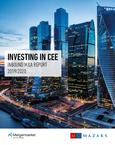
INVESTING IN CEE INBOUND M&A REPORT 2019/2020
Mergers and acquisitions momentum continued, with 726 deals clocked – the same number as in 2018.
A drop in total value of publicly disclosed transactions may indicate fewer big-ticket deals, but this does not include two undisclosed investments in Russian LNG — among others examples – which are likely to have been large.
While sanctions continue to weigh on Russia, the region’s largest economy, its recovery from recession continues steadily, with three consecutive years of growth. Investments in Russian energy, technology, and retail number among the top ten deals this year, along with transactions from the Polish leisure sector to telecommunications in Bulgaria.
These are indicative of the region’s economic diversification, one of its main strengths. Location is a clear competitive advantage, with the more developed economies of Western Europe on one side, and the fast-growing markets of Asia and the Middle East on the other.
For many investors, the region brings some of the benefits of both. Growth is higher than in Western Europe – and valuations more attractive – and unlike many emerging markets, investment is supported by a general political and economic stability and a relatively pro-business outlook.
We would like to introduce you the new Mazars publication "INVESTING IN CEE INBOUND M&A REPORT 2019/2020". We hope it's going to be beneficial for your transaction business. Please find more details in attached survey.


